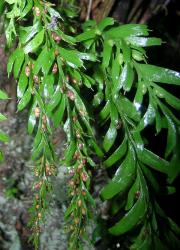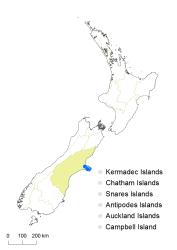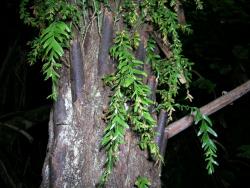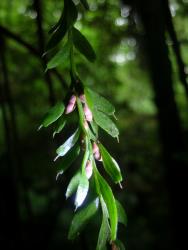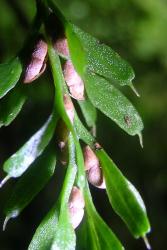Epiphytic or rarely terrestrial ferns. Aerial stems pendent, 60–510 mm long, 15–35 mm wide, unbranched or rarely 1-forked, of indeterminate growth eventually terminated by small sterile leaf or sporophyll. Leaves narrowly oblong to narrowly ovate, straight or falcate or rarely sigmoid, spirally arranged, dull green on both surfaces, coriaceous; the longest 10–25 mm long, 2.5- 7 mm wide, borne from just above to just below mid-stem; apices emarginate, truncate or cuspidate, with a mucro 1–2.5 mm long. Sporophylls mostly in the distal half of the stem, or a few occurring throughout. Synangia 2.5–6 mm long, 1–2 mm high; lobes equal, conic to round-ended; the lower surface of each lobe appressed to the subtending leaf margin along all or most of its length; the conic apices projecting laterally or slightly downwards.
This species is morphologically intermediate between T. elongata and T. tannensis. It differs from T. elongata in having mostly emarginate to truncate leaves, compared to acuminate or cuspidate leaves in that species. It differs from T. tannensis in having round-ended or only slightly pointed synangia with the apices projecting laterally or downwards, compared to usually strongly pointed synangia with the apices pointing upwards in T. tannensis.
South Island: Canterbury.
Altitudinal range: 120–610 m.
Tmesipteris horomaka has only been recorded from Banks Peninsula and the Port Hills near Christchurch where it appears to be the predominant species of the genus.
Tmesipteris horomaka occurs most frequently as an epiphyte on trunks of the tree ferns Cyathea dealbata, C. smithii and Dicksonia squarrosa in podocarp, broadleaved and beech forest. A single collection has also been recorded from Phormium peat on a humid, shaded, cliff face (CHR 355608).
Tmesipteris horomaka was given a conservation status of Nationally Critical by de Lange et al. (2013).
n = c. 208 (Perrie et al. 2010).
Plants resembling Tmesipteris horomaka have been collected from Westland (CHR 325664) and Stewart Island (WELT P011165). They have large spores, suggesting that they may be octoploids, but have more distinctly biconic synangia than T. horomaka from Banks Peninsula. The specimens were treated as incertae sedis by Perrie et al. (2010) and require further investigation.



